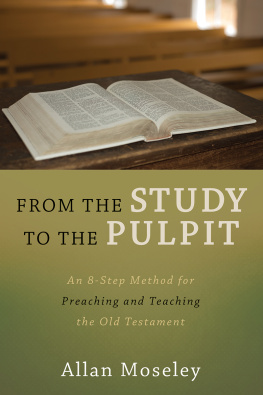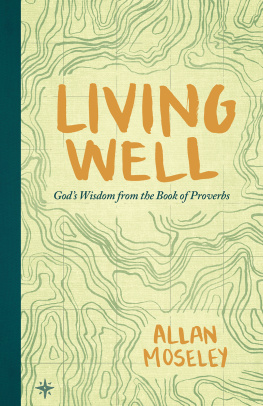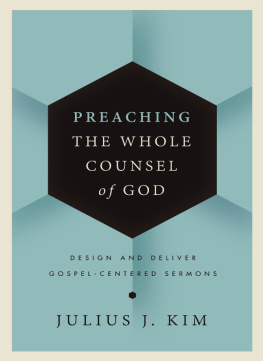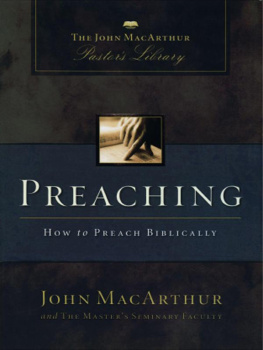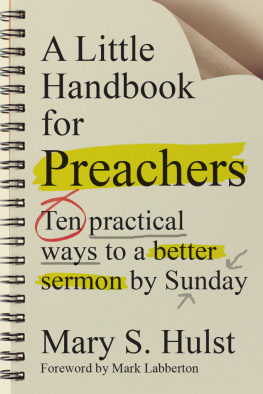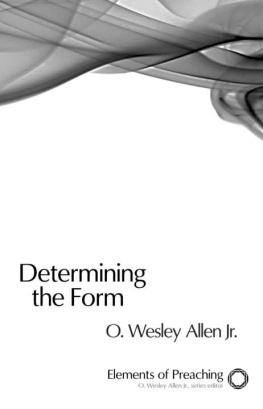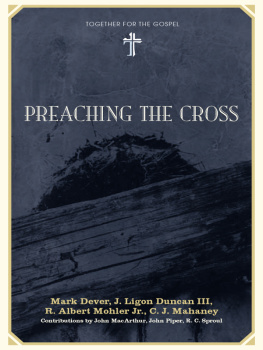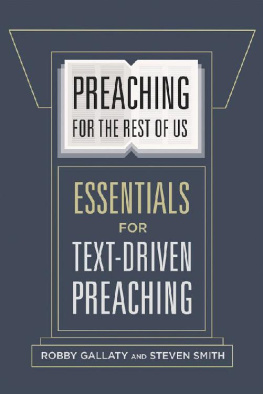FROM THE STUDY TO THE PULPIT
An 8-Step Method for Preaching and Teaching the Old Testament
Allan Moseley

LEXHAM PRESS
From the Study to the Pulpit: An 8-Step Method for Preaching and Teaching the Old Testament
2017 by Allan Moseley
Lexham Press, 1313 Commercial St., Bellingham, WA 98225
LexhamPress.com
First edition by Weaver Book Company.
All rights reserved. You may use brief quotations from this resource in presentations, articles, and books. For all other uses, please write Lexham Press for permission. Email us at .
Unless otherwise indicated, all Scripture quotations are from The Holy Bible, English Standard Version (ESV), copyright 2001 by Crossway, a publishing ministry of Good News Publishers. Used by permission. All rights reserved.
Scripture quotations marked NASB are from the New American Standard Bible. Copyright 1960, 1962, 1963, 1968, 1971, 1972, 1973, 1975, 1977, 1995 by The Lockman Foundation. Used by permission. www.Lockman.org.
Print ISBN 9781683592143
Digital ISBN 9781683592150
Cover design: Frank Gutbrod
For my mother,
Adine Horn Moseley,
with much love and gratitude
CONTENTS
P reaching from the Old Testament is hard for me, so most of the time I dont attempt it. Over the years I have heard no small number of seminary students and pastors speak words like that. The purpose of this book is to help all of us preach and teach the Old Testament more faithfully and effectively. To that end, in the following pages I offer an 8-step method that I hope will be understandable and workable. In presenting this method I have attempted to strike a balance. On the one hand, I want to set the bar high and challenge readers to grow in exegetical proficiency. On the other hand, I hope to provide a simple, usable process that teachers can put to work right away.
Definitions and Presuppositions
This book is about exegesis, or exposition. It would be helpful to define exactly what we mean by those two terms. First, exegesis is the process of determining what a text says and what it means, getting out of the text what is in it. Darrell Bock points out that exegesis has its roots in a Greek term that means to lead out of, and so it means to read out the meaning of the text. It is to explain or interpret a text. Bock further states that exegesis involves working with the texts original language, using sound interpretation principles and moving to application.
Teachers of the Bible sometimes differ concerning how to use the terms exegesis and exposition. For example, Douglas Stuart writes that exegesis is not complete without application and proclamation.
In this book I will use exegesis as Chisholm uses it, but unlike Chisholm I will use exposition to refer to both the process of study and the presentation of the results of that study. I define exposition as the acquired skill of understanding and communicating the meaning of biblical texts, with the help of the Holy Spirit. In a book on pastoral leadership, I provide a more detailed definition of expository preaching, and it may be helpful to say it here: A pastor preaches an expository sermon when he explains the meaning of a text of Scripture in the power of the Holy Spirit, follows the form of the text, applies the message of the text to the lives of hearers, affirms that Jesus is the fulfillment of the passage and the only Savior, and preaches for the purpose of changed lives to the glory of God.
Two principal presuppositions guide the writing of this book. First, the author believes in the divine inspiration and therefore the perfection of the Bible. I affirm the Chicago Statement of Biblical Inerrancy, which states in part, We affirm that Scripture in its entirety is inerrant, being free from all falsehood, fraud, or deceit.this author: the Old Testament is inspired by God, and it is profitable for the church.
Plan of the Book
The eight steps of the method of exposition described in this book constitute the eight chapters. The first two steps, translation and text criticism, are in chapter relate to steps four through eight: exploring the context, defining important words, identifying the big idea, making connections to Jesus, and applying the message.
Rather than provide my own translations, and for the sake of familiarity and consistency, I have elected to use the English Standard Version unless otherwise indicated. I hope readers will also use my footnotes as guides for further study, since in my presentation of numerous issues I touch only the tip of the proverbial iceberg. On the day I finished my final edit I received in the mail a copy of John Goldingays Reading Jesuss Bible: How the New Testament Helps Us Understand the Old Testament . I mention it here as a further resource that will surely be helpful to readers interested in the subject of this book, a resource I doubtless would have used and referred to had it been released earlier.
Audience and Purpose
The intended audience for this book is the great group of people who teach and preach the Old Testament. I hope this book will help pastors in their weekly preparation of sermons. I served as a pastor for fifteen years before serving as a full-time professor of Old Testament and Hebrew. Later I served as a pastor for ten more years while continuing to teach full-time. As a result, I have experienced the pressures of preparing to feed the flock Gods Word every week, which a pastor friend calls the relentless return of the Sabbath.
However, this book is not addressed exclusively to preachers. I also have in mind teachers who may teach the Old Testament in a small group Bible study, a mission setting, a childrens Sunday school class, or in some other context. We need not draw the line between preaching and teaching so boldly. In actual practice, preachers teach and teachers preach. For years I have taught graduate courses in hermeneutics, Hebrew, and the Old Testament to people who were preparing for all sorts of ministries in all sorts of places. I have also taught doctoral seminars in preaching the Old Testament in which the students were primarily pastors. In writing this book, I have had all of those students (past, present, and future) in mind. My hope is that this book will help them and others teach the Old Testament in their varied ministries and avoid some of the mistakes I have made in my own preaching and teaching through the years.
At the risk of being reductionist, people who teach and preach the Old Testament need help in three areas, the first of which is having an intentional process of exposition to follow. In Haddon Robinsons landmark book Biblical Preaching , he writes, Clear, relevant biblical exposition does not take place Sunday after Sunday by either intuition or accident. Good expositors have methods for their study.
This book is an effort to provide such a process to preachers and teachers of the Old Testament. Some books in this genre are written by authors who do not preach, or they preach only occasionally. Such books tend to be heavy on theory and light on practical help for weekly sermon or lesson preparation. In this book I attempt to provide some practical help. In some parts of the book I address hermeneutical issues, but I have attempted to do so only at points where knowledge of such matters is absolutely necessary to become an excellent expositor. I also illustrate principles of exposition that originate with my own teaching and preaching over the decades.

